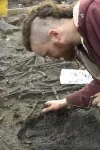(Press-News.org) Some animals possess the remarkable ability to regenerate lost structures, exemplified by a lizard regrowing its tail. However, this regenerative process must be tightly regulated by the body to ensure proper tissue organization and to prevent abnormal growths, such as cancer. Yet, the precise mechanisms underlying this regulation are not well known. In a recent study published in PLOS Genetics, researchers at the University of Illinois Urbana-Champaign have identified an RNA-regulator called Brat as a key player in restraining tissue regeneration through its modulation of downstream growth factors.
“There are constraints and protective factors that are important for making sure that regenerating tissue minimizes mistakes, but these haven’t been well studied,” said Rachel Smith-Bolton (GNDP/RBTE), an associate professor and associate head of cell and developmental biology. “When tissue regenerates, such as from a wound, even without any mutations, it sometimes makes mistakes, which I find really interesting. We want to explore what are the mistakes that can happen, and how can you protect against those mistakes.”
The team, led by Smith-Bolton, along with Syeda Nayab Fatima Abidi, a former graduate student in Smith-Bolton’s lab and first author on the study, and Felicity Ting-Yu Hsu, a current graduate student in the lab, investigated the genetic factors influencing regeneration of wing imaginal discs in Drosophila melanogaster, the common fruit fly. Drosophila larvae harbor imaginal discs, which serve as precursors for various appendages like wings, legs, and antennae. The intricate expression of genes within these discs dictates cell fate, or what appendage the cells will become, and the patterning.
Smith-Bolton says the process can be thought of in terms of growing a hand — the cells may be instructed to become fingers, but the patterning is what ensures you don’t end up with 5 thumbs rather than the usual fingers.
To determine the genes involved in this process, the researchers induced cell death in the wing imaginal discs of fly larvae, resulting in damaged wing discs that subsequently regenerated during development. By comparing wings of adult flies with various mutations to those of control flies, they pinpointed Brat, an mRNA regulator, as a crucial component in regenerative growth. Flies with a mutation that reduced Brat were better able to regenerate their developing wings compared to controls, indicating that Brat specifically works to restrain and control regenerative growth.
“The way fly genes are named is based on the mutant phenotype,” explained Abidi. “Brat gets its full name, Brain Tumor, because in mutants it causes tumors in the brain. This is because it controls whether stem cells are able to differentiate or not. However, there are no stem cells in wing imaginal discs, so it’s interesting that in our results Brat is still essentially performing the same kind of function, controlling whether and how much cells differentiate.”
While flies with reduced Brat demonstrated improved wing regeneration, this enhancement came with a trade-off: they exhibited a deficiency in bristles and veins within specific wing patches where damage had occurred. According to the researchers, this suggests a misstep in cell-fate specification at the wing margin, attributable to the unrestrained growth facilitated by reduced Brat expression.
Further investigation revealed that Myc, a downstream target of Brat and a growth factor, also plays a pivotal role in this process. Flies with Myc overexpression mirrored the phenotypes observed in Brat-reduced flies, underscoring the delicate balance required for proper regeneration.
“Brat reduces expression of its targets, and because Myc is a target of Brat, overexpressing Myc seems to result in the same phenotype as reducing Brat,” explained Smith-Bolton. “What was really interesting is no matter what we tried, we weren’t able to do the opposite and reduce Myc expression using our normal tools and tricks. This tells us that Myc is probably very tightly regulated in regenerating tissue.”
Hsu's ongoing research focuses on elucidating Myc's role in regeneration and its regulatory mechanisms. In her recent work, she was able to find an existing allele that causes underexpression of Myc in the flies. Surprisingly, this underexpression resulted in similar phenotypes to overexpression of Myc, suggesting a delicate balance in Myc’s expression is needed for proper regeneration.
“This just underscores the fact that you need the right amount of Myc during regeneration or you’re going to get mistakes,” said Smith-Bolton. “And we’re exploring now exactly what that amount is and how it’s regulated.”
Overall, the researchers concluded that Brat appears to act as a protective growth factor, constraining downstream growth factors such as Myc, and preventing errors in cell patterning and cell fate in regenerating tissue.
Given the presence of Brat orthologs — genes with similar function — in various species, including humans, these findings open the door for understanding and potentially manipulating regeneration in human contexts, particularly in curbing uncontrolled growth as seen in cancer.
“Though we didn’t look specifically at cancer, that is definitely the concern when you have a regenerative process that is unchecked, because the potential is that it could develop into a tumor,” said Abidi. “There have to be mechanisms in place that stop the process at the right time so that you are not just getting like a blob of growth, you're getting something that's functional. Uncovering the mutations that lead to unconstrained growth like this is a step towards understanding how those kinds of cancers develop.”
The study was funded by the National Institutes of Health and the Roy J. Carver Charitable Trust, can be found at https://doi.org/10.1371/journal.pgen.1011103
END
Researchers identify key regulators underlying regeneration in Drosophila
2024-03-19
ELSE PRESS RELEASES FROM THIS DATE:
HIV in cell culture can be completely eliminated using CRISPR-Cas gene editing technology, increasing hopes of cure
2024-03-19
**Note: the release below is a special early release from the European Congress of Clinical Microbiology and Infectious Diseases (ECCMID 2024, Barcelona, Spain, 27-30 April). Please credit the congress if you use this story**
New research presented early ahead of this year’s European Congress of Clinical Microbiology and Infectious Diseases (ECCMID 2024, Barcelona, 27-30 April) from a team of researchers in the Netherlands shows how the latest CRISPR-Cas gene editing technology can be used to eliminate all ...
UT researchers investigate how freshwater diatoms stay in the light
2024-03-19
Spring weather brings welcome conditions for flowers and plant life to bloom across the land. The right mixture of temperature, moisture, and light helps keep the green world vibrant.
Underwater plant life generally responds to similar environmental encouragements, but a curious discovery in Lake Erie circa 2012 led microbiologists to study an unseasonal display of winter abundance. Blooms of diatoms—microscopic, photosynthetic algae—were alive and well beneath (and within) the lake’s ...
Cape Lion was genetically diverse prior to extinction, researchers find
2024-03-19
Cape lions used to roam the Cape Flats grassland plains of South Africa, in what is now known as Western Cape Providence. When Europeans arrived in South Africa in the mid-1600s, Cape lions, along with many other African carnivores and herbivores, were hunted as agricultural practice to protect livestock and humans. By the mid-1800s, less than 200 years since European arrival, Cape lions had been hunted to extinction.
European naturalists described the Cape lion as having a particularly black mane and as being morphologically distinct. However, alternative depictions and descriptions of Cape ...
U.S. could cut cervical cancer cases & deaths by up to 20% if more patients got follow-up after screening, study suggests
2024-03-19
Getting screened for cervical cancer isn’t fun. And getting an alert that your initial exam showed a potential sign of trouble, and that you need to go back for a test or procedure to rule out cancer, is even less fun.
Plus, those follow-up procedures can cost hundreds of dollars, even though a law makes the initial cervical cancer screening test free to all eligible patients.
So it’s no wonder that many of those eligible don’t get screened in the first place – and that among those who get screened and have initial abnormal ...
Pushing the limit of the periodic table with superheavy elements
2024-03-19
Scientists from Massey University in New Zealand, the University of Mainz in Germany, Sorbonne University in France, and the Facility for Rare Isotope Beams (FRIB) discuss the limit of the periodic table and revising the concept of the “island of stability” with recent advances in superheavy element research. Their work is the cover feature of the February 2024 Nature Review Physics.
In addition to the Nature Reviews Physics feature, Physics Reports published a review on the atomic electronic structure theory for superheavy elements.
What is the heaviest bound nucleus ...
Synthetic dimension dynamics to manipulate light
2024-03-19
In the realm of physics, synthetic dimensions (SDs) have emerged as one of the frontiers of active research, offering a pathway to explore phenomena in higher-dimensional spaces, beyond our conventional 3D geometrical space. The concept has garnered significant attention, especially in topological photonics, due to its potential to unlock rich physics inaccessible in traditional dimensions. Researchers have proposed various theoretical frameworks to study and implement SDs, aiming at harnessing phenomena like synthetic gauge fields, quantum Hall physics, discrete solitons, and topological phase transitions in four dimensions or higher. Those proposals ...
Greenhouse gas emissions in Global South countries linked with IMF lending policies
2024-03-19
CHAMPAIGN, Ill. — Greenhouse gas emissions significantly increase in countries in the Global South within a few years after initially borrowing from the International Monetary Fund using structural loans, but not when more flexible lending conditions are involved.
However, with countries’ second or subsequent IMF loans, their emissions spike almost immediately, regardless of the lending conditions involved, a recent study suggests.
Structural loans, one of IMF’s two primary lending instruments, specify the precise changes borrowers are required ...
Keto diet prevents early memory decline in mice
2024-03-19
A new study from researchers at the University of California, Davis, shows a ketogenic diet significantly delays the early stages of Alzheimer’s-related memory loss in mice. This early memory loss is comparable to mild cognitive impairment in humans that precedes full-blown Alzheimer’s disease. The study was published in the Nature Group journal Communications Biology.
The ketogenic diet is a low-carbohydrate, high fat and moderate protein diet, which shifts the body’s metabolism from using glucose as the main fuel source to burning fat and producing ketones for energy. UC Davis researchers previously found that mice lived 13% longer on ketogenic diets.
Slowing ...
SARS-CoV-2 spike protein sensitizes nociceptors and evokes nociceptive behaviors
2024-03-19
Alexandria, VA, USA – A study aiming to investigate whether the spike protein of Severe Acute Respiratory Syndrome Coronavirus 2 (SARS-CoV-2) can sensitize nociceptors and promote pain-like behaviors in mice was presented at the 102nd General Session of the IADR, which was held in conjunction with the 53rd Annual Meeting of the American Association for Dental, Oral, and Craniofacial Research and the 48th Annual Meeting of the Canadian Association for Dental Research, on March 13-16, 2024, in New Orleans, LA, USA.
The abstract, “SARS-Cov-2 Spike Protein Sensitizes ...
mRNA lipid nanoparticles for next-generation oral cancer tumor suppressor therapy
2024-03-19
Alexandria, VA, USA – A study aiming to develop a Lipid nanoparticles (LNP) platform for treating oral squamous cell carcinoma (OSCC) utilizing p53 mRNA was presented at the 102nd General Session of the IADR, which was held in conjunction with the 53rd Annual Meeting of the American Association for Dental, Oral, and Craniofacial Research and the 48th Annual Meeting of the Canadian Association for Dental Research, on March 13-16, 2024, in New Orleans, LA, USA.
The abstract, “mRNA Lipid Nanoparticles for Next-Generation ...







